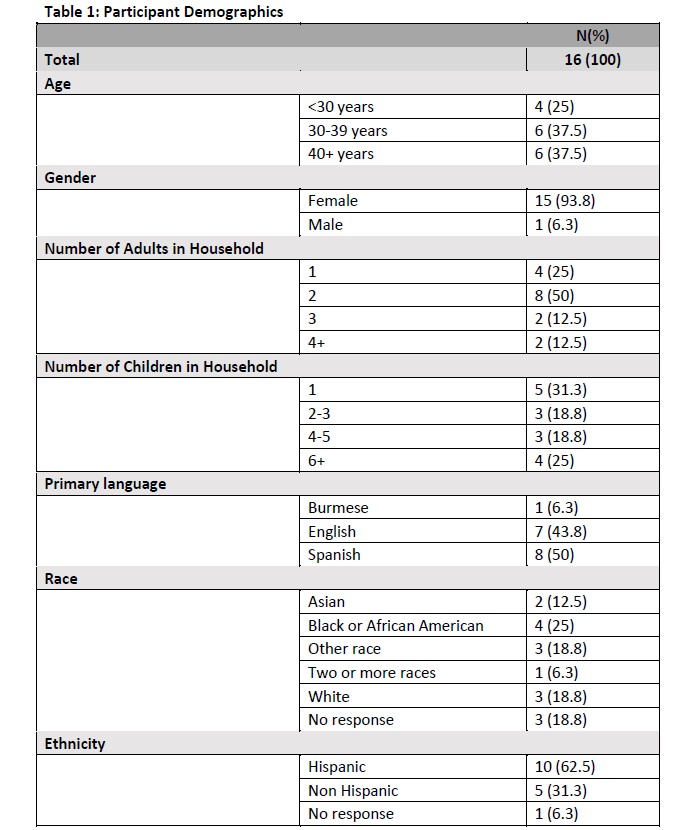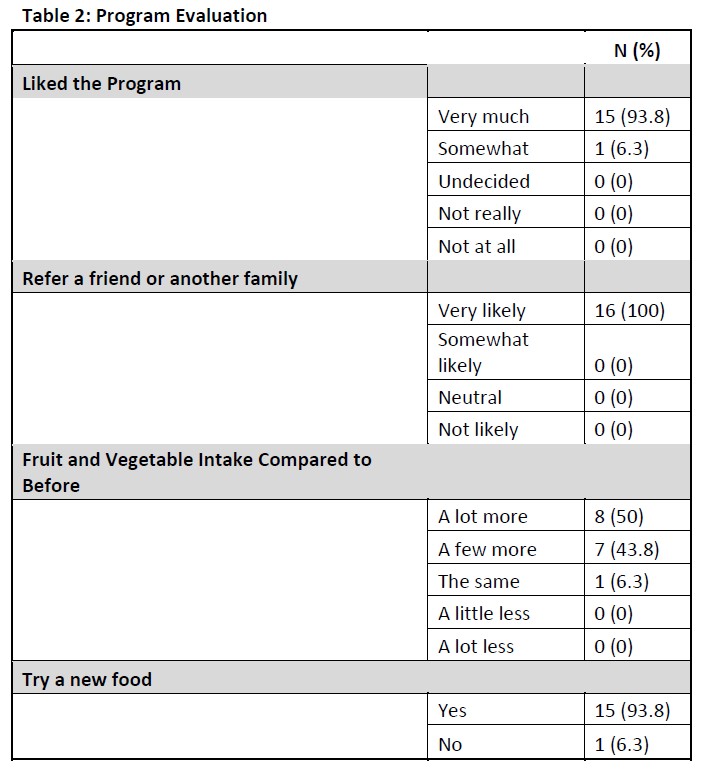Health Equity/Social Determinants of Health
Category: Abstract Submission
Health Equity/Social Determinants of Health III
106 - Feasibility Trial of Fresh Produce Delivery to Families in Home Visiting Programs
Saturday, April 23, 2022
3:30 PM - 6:00 PM US MT
Poster Number: 106
Publication Number: 106.212
Publication Number: 106.212
Laura M. Plencner, Children's Mercy Hospitals and Clinics, Prairie Village, KS, United States; Aliyah L. Hoffmann, Children’s Mercy Hospital, Shawnee, KS, United States; Jean L. Raphael, Baylor College of Medicine, Houston, TX, United States; Jeffrey D. Colvin, Children's Mercy Hospitals and Clinics, Kansas City, MO, United States

Laura Plencner, MD
Associate Professor of Pediatrics
Children's Mercy Kansas City
Prairie Village, Kansas, United States
Presenting Author(s)
Background: Over 13 million children are food insecure, which is associated with poorer child physical and mental health. Home delivery of produce may improve food security of low-income families. This study assessed feasibility and acceptability of leveraging a home visiting program to directly provide food to families with young children.
Objective: We completed an 8-week prospective feasibility trial of direct food provision using produce from our hospital’s community garden and regional food bank using mixed methods evaluation.
Design/Methods: Twenty-five low-income families participating in an infant home visiting program were enrolled. Produce was harvested from the garden, combined with free food bank produce, delivered to home visitor program office weekly, and then delivered to the family’s home by home visitor. Parents completed surveys to evaluate program satisfaction using Likert scales. Results were analyzed with descriptive statistics. Semi-structured interviews were conducted with 8 participants in English or Spanish. Transcripts were coded using deductive and inductive methods, and thematic analysis completed.
Results: Overall participating families were large and diverse in race, ethnicity, and language. (Table 1) In total 286 bags (1900 lb) of produce were delivered (average weight of 6.8lb/bag; average 6 types of produce/bag). Over half (64%) of participants completed the survey. A majority of participants rated liking the program “very much” (94%) and they would recommend it to another family (100%). Participants reported higher intake of fruits and vegetables compared to before the program (50% “a lot more”; 44% “a little more”) and 94% tried a new food. (Table 2) The program cost $48.80/family for materials (i.e., bags, coolers) and delivery. Thematic analysis of interviews identified (a) food variety and delivery by a familiar person as important, (b) the need for cooking instructions/recipes for the new foods that participants tried, and (c) the positive program impact on the family food purchasing, diet, and budget. (Table 3)Conclusion(s): Direct food provision to families enrolled in a home visiting program was acceptable to families and led to increased fruit and vegetable intake and exposure to new foods. This support a larger trial with a comparison group to evaluate the effectiveness of improving food security and the fruit and vegetable consumption. Partnerships between healthcare institutions and community organizations serving families with young children may make initiatives to address food insecurity and the consumption of fruits and vegetables more effective and feasible.
Participant Demographics Demographic data for 16 participants who completed survey
Demographic data for 16 participants who completed survey
Program Acceptability Survey responses regarding program acceptability
Survey responses regarding program acceptability
Objective: We completed an 8-week prospective feasibility trial of direct food provision using produce from our hospital’s community garden and regional food bank using mixed methods evaluation.
Design/Methods: Twenty-five low-income families participating in an infant home visiting program were enrolled. Produce was harvested from the garden, combined with free food bank produce, delivered to home visitor program office weekly, and then delivered to the family’s home by home visitor. Parents completed surveys to evaluate program satisfaction using Likert scales. Results were analyzed with descriptive statistics. Semi-structured interviews were conducted with 8 participants in English or Spanish. Transcripts were coded using deductive and inductive methods, and thematic analysis completed.
Results: Overall participating families were large and diverse in race, ethnicity, and language. (Table 1) In total 286 bags (1900 lb) of produce were delivered (average weight of 6.8lb/bag; average 6 types of produce/bag). Over half (64%) of participants completed the survey. A majority of participants rated liking the program “very much” (94%) and they would recommend it to another family (100%). Participants reported higher intake of fruits and vegetables compared to before the program (50% “a lot more”; 44% “a little more”) and 94% tried a new food. (Table 2) The program cost $48.80/family for materials (i.e., bags, coolers) and delivery. Thematic analysis of interviews identified (a) food variety and delivery by a familiar person as important, (b) the need for cooking instructions/recipes for the new foods that participants tried, and (c) the positive program impact on the family food purchasing, diet, and budget. (Table 3)Conclusion(s): Direct food provision to families enrolled in a home visiting program was acceptable to families and led to increased fruit and vegetable intake and exposure to new foods. This support a larger trial with a comparison group to evaluate the effectiveness of improving food security and the fruit and vegetable consumption. Partnerships between healthcare institutions and community organizations serving families with young children may make initiatives to address food insecurity and the consumption of fruits and vegetables more effective and feasible.
Participant Demographics
 Demographic data for 16 participants who completed survey
Demographic data for 16 participants who completed surveyProgram Acceptability
 Survey responses regarding program acceptability
Survey responses regarding program acceptability